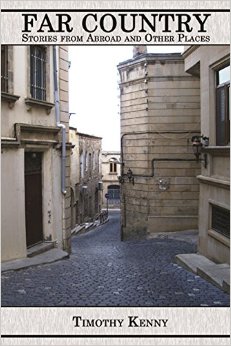 Tim Kenny has a tendency to end up in faraway places, particularly those on the edge of political or social change. As Foreign Editor for USA Today and while employed at a non-profit journalism organization, he visited or lived in a number of distant countries: Sarajevo during the siege, Tel Aviv, Belfast’s “most bombed hotel in Europe,” Kosovo, Kabul, and many others. Far Country: Stories from Abroad and Other Places (Bottom Dog Press, April 2015) is a collection of essays in which Kenny recounts his travels, hoping “to tell readers something about the ways in which unusual places are, indeed, different, and why that is so.”
Tim Kenny has a tendency to end up in faraway places, particularly those on the edge of political or social change. As Foreign Editor for USA Today and while employed at a non-profit journalism organization, he visited or lived in a number of distant countries: Sarajevo during the siege, Tel Aviv, Belfast’s “most bombed hotel in Europe,” Kosovo, Kabul, and many others. Far Country: Stories from Abroad and Other Places (Bottom Dog Press, April 2015) is a collection of essays in which Kenny recounts his travels, hoping “to tell readers something about the ways in which unusual places are, indeed, different, and why that is so.”
In Pristina, Kosovo, he navigates dark streets during power outages as packs of feral dogs nip at his heels. He is shot at in Sarajevo in 1992, where marking oneself as a journalist did not guarantee safe passage through bullet-pocked city streets. In Azerbaijan, he spends a month teaching journalism to adult students and struggles to teach the Western journalism he knows—unbiased, objective—to students that “have grown up in the aftermath of communism in Baku, Azerbaijan, a place choked by government sponsored propaganda and ‘public relations,’ not fact-based journalism.” Kenny also writes about experiences closer to home, including an observation of Detroit’s decay—particularly relevant to Kenny, who was born there—and his thoughts on being an older father to a young girl.
Most essays are based on the interactions Kenny has with neighbors, coworkers, and strangers he encounters in the various cities he passes through. Conversations are presented in full to showcase cultural differences: his driver in Kosovo confuses Kenny when, after a car wash, the inside of the car is wet; Kenny angers his coworkers when he asks why women in Kosovo never wear skirts; he talks with an Afghan colleague in Kabul about preparing for death whenever one walks out the door. Along with these specific instances, Kenny incorporates broader historical and cultural context for each place he passes through.
Kenny is adept at describing setting. When he returns to Detroit after years away, he observes that he and the city are both “slouching toward the end of interesting lives.” In Pristina a “November dusk … falls with the certainty of a safe tossed off a ten-story building.” Yet attempts at characterizing humans are stilted, sometimes to the point of blandness: people are simply short/tall/young/old, occasionally “solidly-built.”
Though Kenny categorizes this collection as “New Journalism”—creative nonfiction in which the author can freely insert their subjective point of view— these travel essays present experiences without spending many words to explore how the author’s opinions, beliefs, and worldview were affected by what he witnessed. The reader gets acquainted with Kenny through narration of his exchanges with other people, but he resists processing these events more deeply in the text. Though the book is written in first person, the man himself remains inscrutable.
The author seems resistant to let his thinking evolve as his views are challenged by the places and people he encounters. About seeing women wearing burqas in Iraq, without delving into any historical or cultural significance of the garment, he says, “I found it impossible to wrap my mind around this cultural phenomenon and no longer bother trying.” When learning of some mysterious transgression committed by one of his coworkers he comments, “I occasionally hear unsolicited confessions that reveal sins of omission and other missteps in otherwise decent lives. Wrongdoing appears more than I would like.” This brusque, moralizing tone affects the way the author comes across on the page, and conflicts with his own statement that “finding out why people see the world differently is what matters.”
As a collection, the vaguely declared theme of highlighting the differences between unusual places is unsuccessful in tying the essays together or providing a coherent, overarching narrative. The essays present interesting events, meticulously observed and recorded, but fail to interrogate why and how the places and people are “different.” Additionally, one wonders: different than what? Different than the United States? Different than each other? Though Kenny’s anecdotes from abroad are thought-provoking, the lack of in-depth inquiry into these experiences and how they affect author leaves the reader wanting more.
Rating: 2 out of 5 stars


